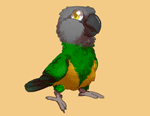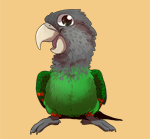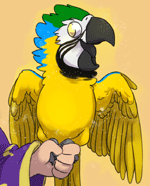 Kili
Type: Senegal Parrot
Genus: Poicephalus
Species: Senegalus
Subspecies: Mesotypus
Sex: Female
Weight: 120 grams
Height: 9 inches
Age: 17 years, 5 months
|
 Truman
Type: Cape Parrot
Genus: Poicephalus
Species:Robustus
Subspecies: Fuscicollis
Sex: Male
Weight: 330 grams
Height: 13 inches
Age: 15 years, 9 months
|
 Rachel
Type: Blue & Gold Macaw
Genus: Ara
Species:ararauna
Sex: Female
Weight: 850 grams
Height: 26 inches
Age: 13 years, 5 months
|
List of Common Parrots:
Parakeets:
Budgerigar (Budgie)
Alexandrine Parakeet
African Ringneck
Indian Ringneck
Monk Parakeet (Quaker Parrot)
Parrotlets:
Mexican Parrotlet
Green Rumped Parrotlet
Blue Winged Parrotlet
Spectacled Parrotlet
Dusky Billed Parrotlet
Pacific Parrotlet
Yellow Faced Parrotlet
Lovebirds:
Peach Faced Lovebird
Masked Lovebird
Fischer's Lovebird
Lilian's (Nyasa) Lovebird
Black Cheeked Lovebird
Madagascar Lovebird
Abyssinian Lovebird
Red Faced Lovebird
Swindern's Lovebird
Lories and Lorikeets:
Rainbow Lorikeet
Conures:
Sun Conure
Jenday Conure
Cherry Headed Conure
Blue Crowned Conure
Mitred Conure
Patagonian Conure
Green Cheeked Conure
Nanday Conure
Caiques:
Black Headed Caique
White Bellied Caique
Poicephalus Parrots:
Senegal Parrot
Meyer's Parrot
Red Bellied Parrot
Brown Headed Parrot
Jardine's Parrot
Cape Parrot
Ruppell's Parrot
Eclectus:
Eclectus Parrot
African Greys:
Congo African Grey (CAG)
Timneh African Grey (TAG)
Amazons:
Blue Fronted Amazon
Yellow Naped Amazon
Yellow Headed Amazon
Orange Winged Amazon
Yellow Crowned Amazon
Cockatoos:
Cockatiel
Galah (Rose Breasted) Cockatoo
Sulphur Crested Cockatoo
Umbrella Cockatoo
Moluccan Cockatoo
Bare Eyed Cockatoo
Goffin's Cockatoo
Macaws:
Red Shouldered (Hahn's) Macaw
Severe Macaw
Blue And Gold Macaw
Blue Throated Macaw
Military Macaw
Red Fronted Macaw
Scarlet Macaw
Green Winged Macaw
Hyacinth Macaw
Glossary of Common Parrot Terms
|
| | Monday February 4th, 2013 |
|
Tom Sawyer your parrot into doing what you want. Want your parrot to try a new food? Or to accept a new toy? Or to step up reliably? Or to fly to you when called? Why is it that our parrots manage to pick up on everything we don't want them to do and then serve little interest in doing what we try to encourage? For this, Tom Sawyer offers a great lesson and plays a marvelous role model!
Recall how Mark Twain's Tom Sawyer made his friends pay him for the opportunity to whitewash his aunt's fence and thus completing Tom's chores for him. Instead of paying (with toys and food) his friends to do his work for him, Tom made the work so lucrative that his friends agreed to pay him just to have the chance to try it. Well this unlikely literary lesson comes in very handy for parrot training!
Tom said to himself that it was not such a hollow world, after all. He had discovered a great law of human action, without knowing it namely, that in order to make a man or a boy covet a thing, it is only necessary to make the thing difficult to attain. If he had been a great and wise philosopher, like the writer of this book, he would now have comprehended that Work consists of whatever a body is obliged to do, and that Play consists of whatever a body is not obliged to do. And this would help him to understand why constructing artificial flowers or performing on a tread-mill is work, while rolling ten-pins or climbing Mont Blanc is only amusement. (From Chapter II of Tom Sawyer by Mark Twain)

I have noticed the same effect to work marvelously on my parrots when it comes to training. Doing something directly for a treat is "work." Believe it or not, often times our parrots will be more willing to do stuff without getting treats!. Now isn't that something? You save money on bird food and the bird returns the favor by doing more tricks/good behaviors for you? Well that's the Tom Sawyer effect for you.
I have several examples to share with you. First a more illustrative recent one and then some others that have worked very well in the long term. Lately I've been working with Kili on some new tricks and desensitizing Truman more to being grabbed. The downside to working on these new behaviors with the birds is that if I spend a lot of treats working on non-flight stuff with them, then they will fill up and not want to fly recalls for practice/exercise. A large portion of my parrot training involves flight because I think it's the best exercise and bonding experience but teaching new tricks seems to be mutually exclusive. But it's not!
I got Truman, who has a reputation for being a really stubborn bird, to fly more flight recalls that he was not getting any treats for at all for the opportunity to be grabbed than he would when he gets treats for flying recalls only!!!! Not only did he fly more flight recalls in this process but he also flew them reliably on the first time without any hesitation. Likewise, Kili's recalls have been rock solid and I can use my treats only for working on the new tricks. When I don't have to spend treats on flight, I get the benefit of knowing my birds got some much needed exercise, are dependable fliers, and have lots of treats left over to teach new tricks or behaviors with. The amazing thing is that the birds end up doing more work to get the same amount of food or less than if they just flew the recall for the treat directly.
I have found this method so effective that I even took it another step forward with Truman's grab training. I have Truman flight recall to my hand, then I put him down on his cage (that he lately doesn't like being grabbed from which is why we are working on it), then I grab him but don't give him a treat for that either, and finally I let him do one of his tricks on my hand to earn a treat. Since the birds are more eager to fly or accept handling for the opportunity to do something easy to earn food, I am turning flight recall and grabbing into something I don't have to ever reward with food. For several weeks now the birds have barely received any treats for flying recalls. Instead, they earn an opportunity to perform a trick to earn the food.
I suspect that in their little bird brains they see flight as a difficult way for earning treats but doing tricks as an easy one. So they treat flight as a means of coming over but performing the trick as the easy way to earn a big treat. In other words flying recalls for treats is work but flying over to do a trick is simply coming over to get started. Or it's just more fun to do it the Tom Sawyer way.
Before you have an "aha moment!" and post a comment saying that the birds are getting treats on a continuous interval whereas before I had them on a variable ratio reinforcement schedule, NOPE! They are still on a variable ratio reinforcement schedule which makes this all the more exciting! So a single treat may be rewarding the following sequence with Truman:
1) 50ft flight recall
2) Short flight from hand to cage
3) Grabbing off of cage
4) 50ft flight back to perch
5) Stay until called again
6) 50ft flight recall
7) Short flight from hand to cage
8) Grab from cage
9) Wings Trick
10) Receive reward and fly 50ft back to perch
If getting Truman to do all of the above for a single pellet isn't pulling a Tom Sawyer on him, I don't know what is. Note, the food management level used is comparable to what was done before applying this method.
Now that you are convinced that this is a useful strategy, here is how you can apply it to your own parrots. First and foremost this should apply to stepping up. My parrots never get treats for stepping up at all, yet they do it 100% of the time when asked. Why? Tom Sawyer. The birds have to "white wash the fence" for me by doing the work of stepping up for the opportunity to find out what they'll get to do. Sometimes it's the chance to do a trick, sometimes it's to watch what I'm doing, sometimes a head scratch, sometimes getting groomed, etc. However, since they never get treats for stepping up, this ensures that they won't refuse to step up when they don't desire a treat.
Another place where this applies marvelously is for coming out of the cage. Better yet, I've taught my parrots to station to get to come out. Basically what this means is they climb down to an easy to reach perch for me to take them out rather than me bending my back and my arms into a pretzel to get to where they are. Whenever I come up to the cages, they climb to the perch nearest the door and wait to be taken out. They never get a treat for this, yet they pay me with this work for the opportunity to come out and see what they have in store.
Chaining tricks, variable ratio reinforcement schedules (random rewarding by giving a treat once in a while), and requiring multiple behaviors to earn one treat gets the most exercise for your bird, the most reliable presentation of behavior for you, lowers the dependence on treats, ensures the parrot will behave well anytime/place, saves you treats, reduces your parrot's overeating habits, and ensures the best relationship between you. Now go thank Aunt Polly for giving you this task and put your Sawyer skills to the test by seeing how much more behavior you can get from your parrot for less food.
Part of: Indoor Freeflight, Flight Recall, Cape Parrots, Senegal Parrots
Kili Senegal Parrot Truman Cape Parrot Training Motivation |
|


 Previous Article
Previous Article Next Article
Next Article